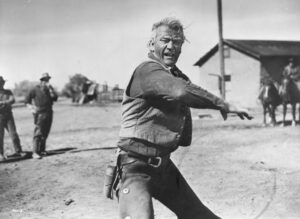Ann-Margret Refused to Call John Wayne ‘Duke’ While Introducing 1 of His Movies

Ann-Margret once starred in one of John Wayne’s lesser-known movies. However, she refused to call him by his popular moniker Duke. Here’s a look at the film they made together — and why she declined to call him by a nickname.
The one time Ann-Margret and John Wayne made a movie together
Ann-Margret is probably most known for her work in musicals, specifically Bye Bye Birdie, Viva Las Vegas, and The Who’s Tommy. However, she also dabbled in the Western genre. She starred alongside Wayne in the mostly forgotten movie The Train Robbers.
Wayne was also known as The Duke or just Duke. According to USA Today, the nickname was derived from his childhood dog. It stuck with him for many years. It continues to be used today — even on the box covers of the DVDs for his movies.
 John Wayne | Silver Screen Collection/Getty Images
John Wayne | Silver Screen Collection/Getty Images
During an interview with Interview Magazine, Ann-Margret explained why she didn’t refer to the Rio Bravo star by this famous name. “When I came to this country, first of all, mother and I didn’t know English,” she said. “I would curtsey, then say, ‘Thank you,’ and then when I was leaving, curtsey. For example, we went to Dallas to introduce a film I did with John Wayne. And I never called him Duke. I just couldn’t. That’s the way I was raised. When you meet someone, you say either Mr. or Mrs. or Miss. You stand up.”
Ann-Margret revealed she treated other famous people in much the same way. For example, she worked with director George Sidney on Bye Bye Birdie and Viva Las Vegas. She always called him Mr. Sidney.
What Ann-Margret thought about John Wayne
Ann-Margret refused to use Wayne’s most famous moniker. However, she had a positive view of the actor. During an interview with Fox News, she was asked what she expected when she met Wayne. “Oh, I didn’t know what to expect,” she revealed. “But when he hugged me, it’s like the world was hugging me. He was so big and wide with that booming voice.
“We were shooting in Durango, Mexico and my parents came down to visit me,” she added. “He was so great with my parents. So absolutely welcoming and gentle with them. And anybody who was great to my parents was on a throne in my eyes.”
How the world reacted to ‘The Train Robbers’
Wayne starred in many classic Westerns, including The Searchers, Stagecoach, and The Man Who Shot Liberty Valance. However, The Train Robbers is mostly forgotten. It didn’t gain a cult following like Once Upon a Time in the West or Dead Man. It wasn’t a critical success either, garnering a 33% rating on Rotten Tomatoes. However, Ann-Margret had some fond memories of making the film — even if she refused to call Wayne by his famous nickname.





